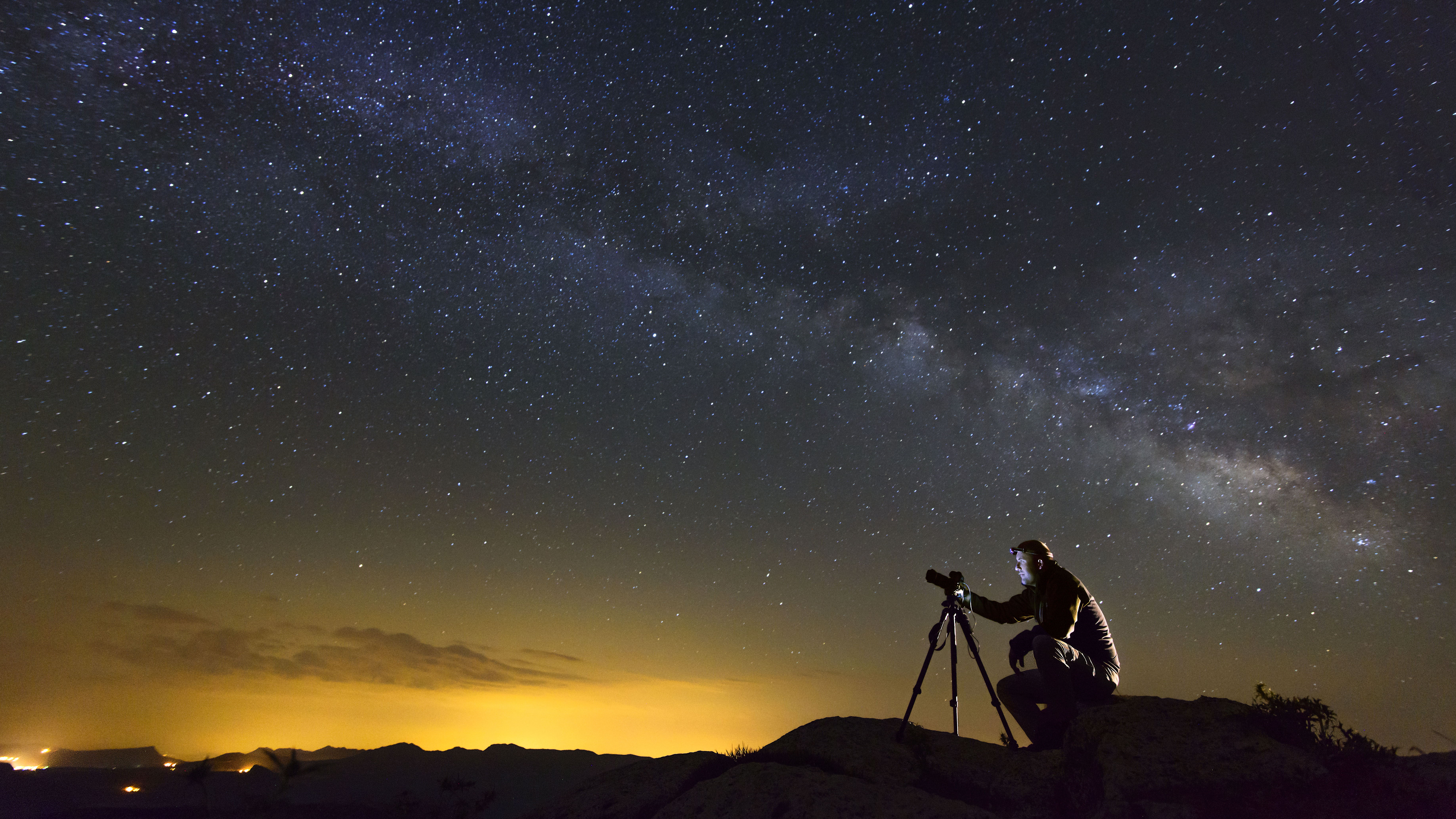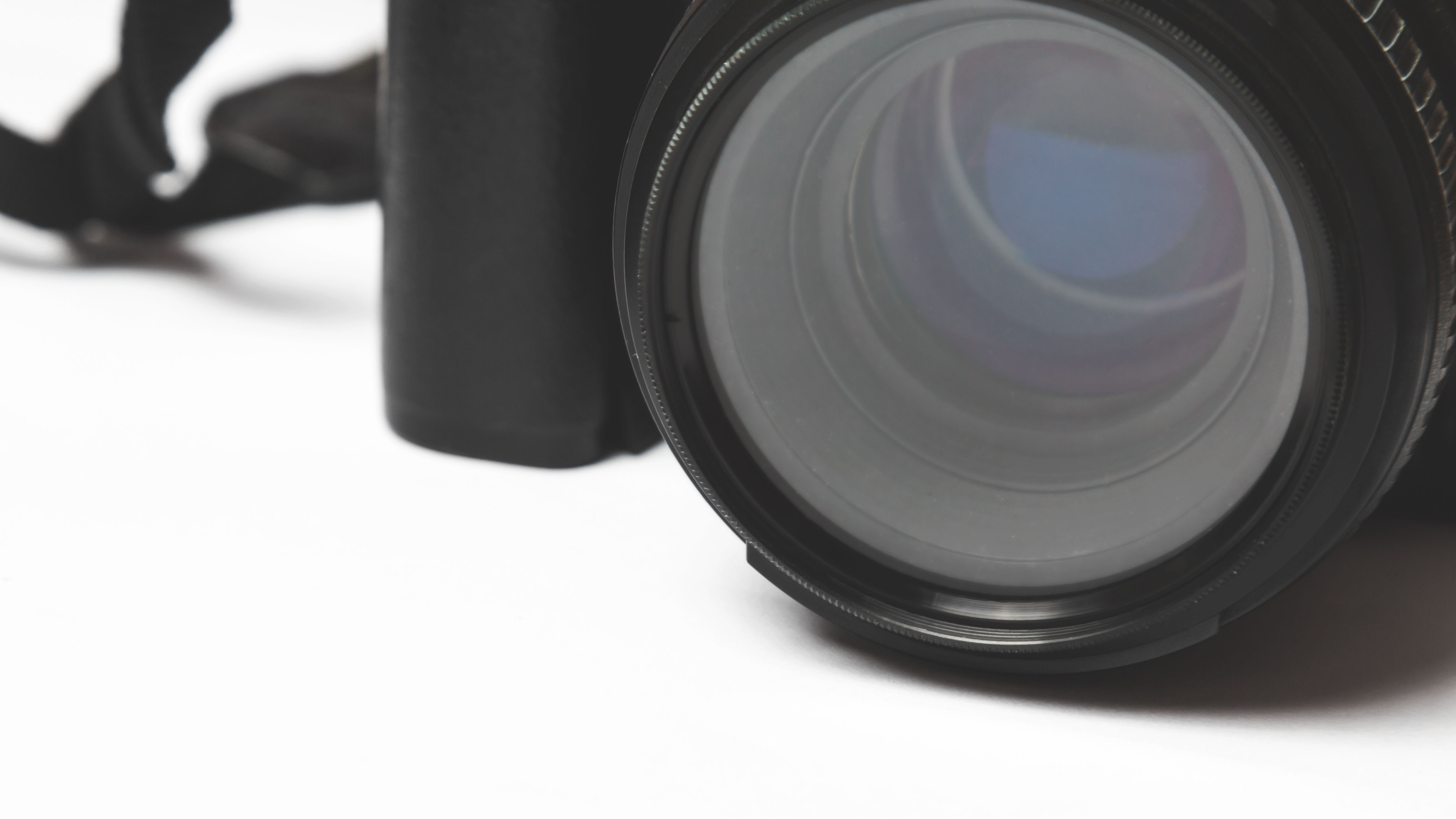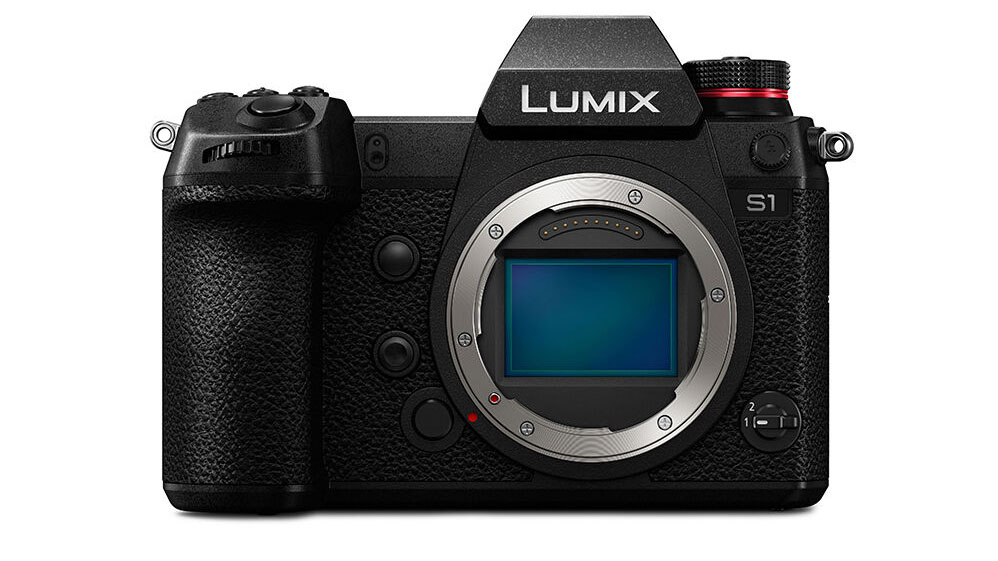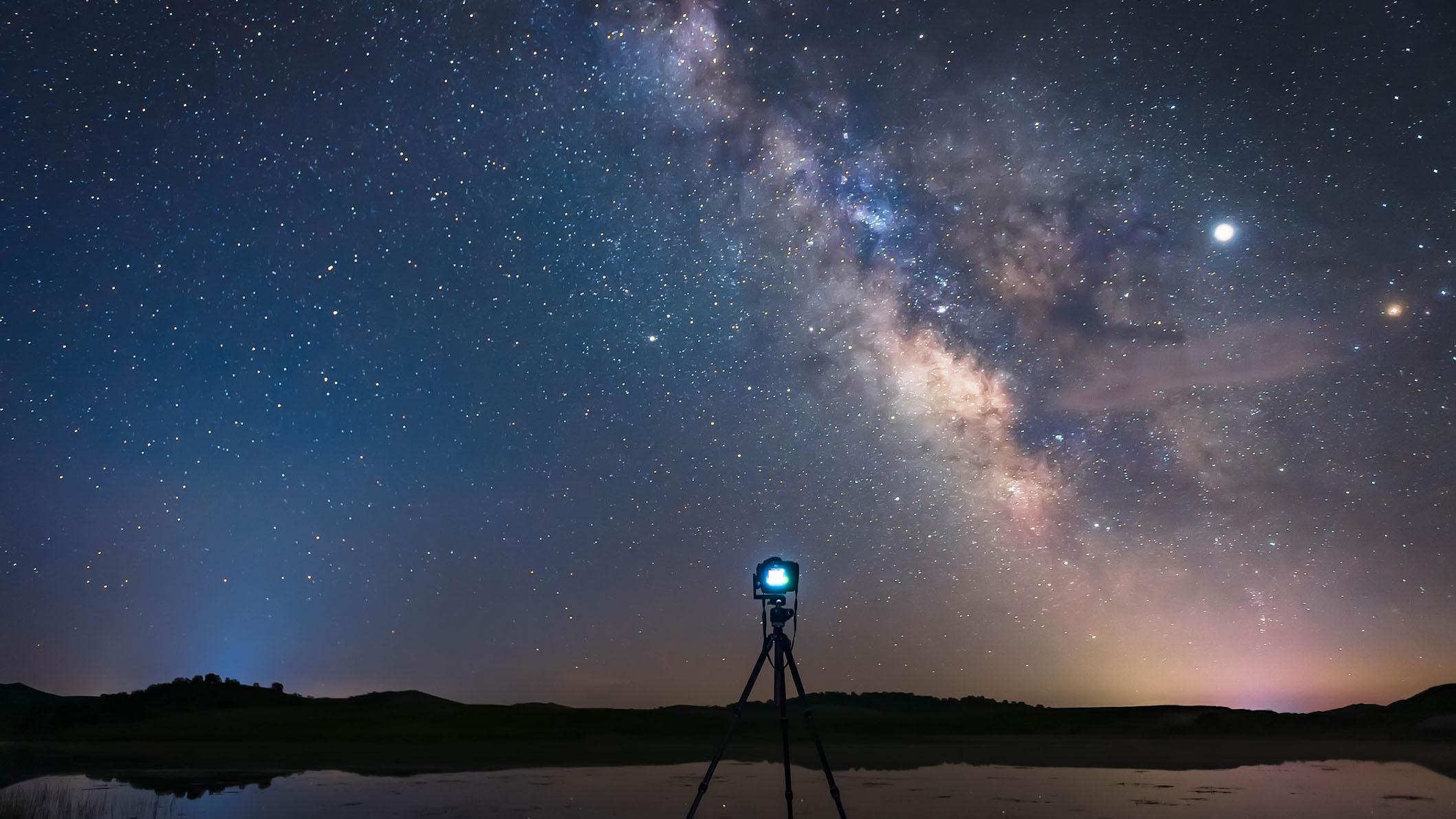DSLR vs Mirrorless cameras for Astrophotography
DSLR vs mirrorless cameras is a debate for the ages, so here's our handy guide to help you decide which is best for you.

DSLR vs mirrorless cameras is a question with no real right or wrong answer, but it's important to know the pros and cons so you get exactly what you're looking for. There was a time when the DSLR - digital single-lens reflex camera - was the undisputed king, that was until mirrorless digital cameras challenged them for that title. Many casual photographers started to opt for the smaller, more lightweight models and thus, the debate began. But could a mirrorless, interchangeable lens camera really produce the same quality of images as a DSLR?
Both are great choices for astrophotography, but there are differences that this guide will navigate you through. Technology has evolved over the years and with it, there's been an increase in investment in mirrorless cameras too. It's not just novice photographers opting for the smaller models but professionals too. Big-name companies such as Canon, Nikon and Sony have produced professional standard mirrorless cameras and exceptional lenses to attach too. Mirrorless models are becoming more widespread and have become the target of the most up-to-date technology. On the other hand, DSLR cameras don't get as much attention in terms of updates but are just as trustworthy as they always were.
While this guide will help you understand the benefits of each design, we do have some other handy guides that are related. Be sure to check out our beginner’s guide to astrophotography and our best cameras for astrophotography. They contain useful insight and will help you get a clearer picture of what's out there in terms of camera choice for astrophotography. However, if it's the DSLR vs mirrorless debate you want to know more about, read on below.
What's the difference between DSLR and mirrorless?
There's a fundamental difference between the two types of camera, and it comes down to the path the light takes from the back of the lens to the sensor. DSLRs use the technology of old film cameras, where the light enters through the lens and hits an angled mirror, before being reflected up and bounced around in a prism into the optical viewfinder. This is how the photographer sees directly down the lens. When you press the shutter button, the mirror lifts to unveil the image sensor. Part of the ‘click’ you hear is the mirror moving out of the way, ready for the image being projected onto the sensor to be captured as the mechanical shutter opens.
Mirrorless cameras, as you might expect, don’t have this function. Instead, the light enters through the lens and is projected straight onto the naked sensor, which sends it live to the viewfinder, which is a screen, or to the screen on the back of the camera. There's still a mechanical shutter in some models, but others make a noise through a small speaker to let you know an image has been taken.
Some cameras, like the Canon EOS Ra and Nikon D810A are made for astrophotography, with specially designed filters over the sensor to better capture the wavelengths of light that come from space.
- Our picks of the Best mirrorless cameras
- Our picks of the Best DSLR cameras

The size and weight difference between DSLR and mirrorless
DSLRs are often branded as the heavier option – while mirrorless cameras have a reputation for being a smaller, lightweight alternative. Put them side by side and this certainly can be the case – digital SLRs are larger than film cameras used to be, and suited to professionals who lug around heavy gear as standard. Mirrorless cameras appeal to beginners and intermediate users, who don’t care for the hassle that comes with heavy equipment.
However, this is changing as mirrorless cameras are being made to appeal to all levels of photographers from amateur to professional. Some high-end options are even as large as their DSLR counterparts (like the Panasonic Lumix S1). A reason for this is that larger sensor sizes are growing in popularity and now you'll see full-frame units (those with a sensor the same size as a 35mm film frame) leading the market. That doesn't mean you have to go bigger and bulkier with mirrorless though, if size, weight and portability are a priority then some brands such as Olympus and Fujifilm excel in making smaller, lighter models.

Lens options and availability
DSLR brands such as Canon, Nikon and Pentax offer everything from telephoto 800mm and 600mm to wide-angle 12mm to 24mm lenses, with third-party manufacturers – such as Sigma, Tokina and Tamron – making lens options more affordable. Popular mirrorless lens needs are covered well too – with only the rarer lens requests being harder to source. The mirrorless market is growing constantly, so if there is a lens missing for your chosen brand, it likely won’t be long until the gap is filled. You can also often use DSLR lenses on mirrorless cameras by investing in an adaptor.
If you want to use your camera in conjunction with one of the best telescopes, then you're in luck, as either kind can be attached with the help of adapters.
Battery life
Rigorous testing shows DSLRs offer better battery life, sometimes allowing up to double the number of shots in one charge. This is simply because DSLR batteries are often bigger, holding more power, and the electronic viewfinders and increased screen use on the mirrorless cameras drain the battery quicker. If your heart is set on mirrorless, and you are likely to use your camera for long periods each day, the easiest solution is to carry a second battery, either in your pocket or in a special battery grip – or invest in a battery pack and charge your camera over USB - many mirrorless cameras offer this option, but it’s rare in DSLRs.
Speed shooting
The professional favorite DSLR, the Canon EOS-1D Mark III, shoots at 16 frames per second (fps), flipping its mirror out of the way every time. This is boosted to 20fps if you lock the mirror up and use an electronic shutter. Meanwhile, current top-level mirrorless cameras shoot at 20fps, or even 30fps, as standard. Some mirrorless models claim a 60fps speed using an electronic shutter, however these set the focus at the first shot and can cause banding to appear on the image. Nikon’s remarkable Z9 offers 120fps, if you don’t mind a stream of 11MP JPEGs.

Autofocus and video
DSLRs have long been the go-to for precision and autofocus quality, but mirrorless technology is beginning to beat them at their own game. Mirrorless cameras tend to offer more focus points than a DLSR, and usually with points positioned closer to the edge of the frame – a particularly valuable feature when photographing in low light, people or wildlife. The silent shooting ability is handy, too, though watch out for the ‘rolling shutter’ effect that can make moving objects in the shot look very strange.
For many years, Canon has led the way in video making with DSLRs, with the 5D series being a particular full-frame favorite with professionals, and its crop-frame models being popular with vloggers and YouTubers. While 4K video is now the norm on high-end DSLRs, the quality of video is rapidly increasing on their mirrorless counterparts – with some newer models offering 6K or 8K, a rate DSLRs simply can’t match. In addition, mirrorless technology offers a trustworthy live autofocus, making filming much more user-friendly for the user. Some mirrorless cameras, such as the Canon EOS R5c and Sony A7Siii, are oriented more toward video work than stills photography.
Other important features
When it comes to the basic functions, DSLRs and mirrorless are neck-and-neck. The image stabilization function on DSLR lenses is matched on mirrorless bodies by an in-body image stabilization system (IBIS) that moves the sensor to compensate for camera movement - and some mirrorless lenses have stabilization too, which works with IBIS for a stronger effect. DSLRs and mirrorless cameras both allow the user to photograph in either JPEG or RAW formats and retain complete manual control over exposure settings, or go into full automatic and let the camera decide.
With fast continuous shooting, up to 8K video frame rates, high ISO and a live monitor with the possibility of overlaying histograms and gridlines on top of any video or image – mirrorless processing certainly trumps the DSLR. That said, the experience and trustworthiness of long-standing camera technology can’t be substituted, and the DSLR has the advantage of a longer battery life coupled with tried and tested quality.
Price
The good news is that entry-level mirrorless cameras and DSLRs have come down in price, so if you're looking to get into photography/astrophotography you can get a good deal. The bad news is those affordable entry-level models won't offer the high-end specs of some of the fancier cameras on the market.
As with most technology, both types of cameras see their prices reduce as newer, more efficient models are released. However, we know this is likely to happen far more frequently with mirrorless cameras than with DSLRs, as fewer new models of the older technology are being released. Professional-level cameras tend to sit around the same price bracket anyway – with little difference between the types.
Lenses are often the largest expense of cameras and you'll likely find that mirrorless lenses are more expensive. Unfortunately, there's a smaller pre-owned market for them which keeps the MSRP high.
Join our Space Forums to keep talking space on the latest missions, night sky and more! And if you have a news tip, correction or comment, let us know at: community@space.com.
Get the Space.com Newsletter
Breaking space news, the latest updates on rocket launches, skywatching events and more!
Karen Edwards is an editor and writer from London, who specializes in responsible tourism, sustainable living and emotional well-being. She writes for a variety of national and international titles, including High Life by British Airways, Breathe, Grazia, Metro, The Independent, The Telegraph and Time Out. Karen inherited her love for the planet at a young age while travelling with her parents. She lives in between London and South Australia with her marine biologist fiancé.
- Ian EvendenContributor











